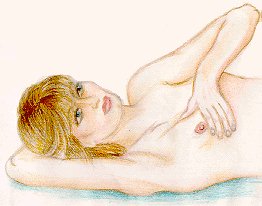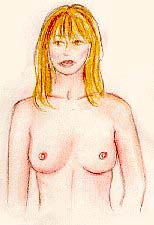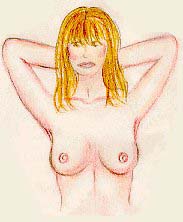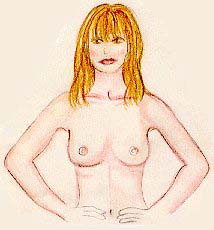Why?
It is recommended by healthcare professionals that all women over the age of 20 examine their breasts once a month. By examining your breasts regularly, you will know how your breasts normally feel. If a change should happen in your breasts, you will be able to identify it and let your doctor know. Most lumps are found by women themselves. If you find any lumps, thickenings or changes, tell your doctor right away. Remember, most breast lumps are not cancerous, but you don't know if you don't ask. Breast cancer can be successfully treated if you find it and treat it early. Delaying the diagnosis of breast cancer does not change the diagnosis, it only worsens the outcome.
When to Do a Breast Self-Examination
You should do a Breast Self-Examination (BSE) every month 2 or 3 days after your period. If you do not have regular periods, just do it the same day every month...like the first... or the tenth...or the day that matches your birthday. (Note: just before your period or during pregnancy, your breasts may be somewhat lumpy or more tender.) If you are taking HRT, talk with your doctor about when to do BSE.
How to do BSE
- Lie down. Flatten your right breast by placing a pillow under your right shoulder. Place your right arm behind your head.
- Use the sensitive finger pads (where your fingerprints are, not the tips) of the middle three fingers on your left hand. Feel for lumps using a circular, rubbing motion in small, penny-sized circles without lifting the fingers. Powder, oil or lotion can be applied to the breast to make it easier for the fingers to glide over the surface and feel changes.
- Press firmly enough to feel different breast tissues, using three different pressures. First, light pressure to just move the skin without jostling the tissue beneath, then medium pressure pressing midway into the tissue, and finally deep pressure to probe more deeply down to the ribs or to the point just short of discomfort.
- Completely feel all of the breast and chest area up under your armpit, and up to the collarbone and all the way over to your shoulder to cover breast tissue that extends toward the shoulder.
- Use the same pattern to feel every part of the breast tissue. Choose the method that you find easiest:
-- Lines: Start in the underarm area and move your fingers downward little by little until they are below the breast. Then move your fingers slightly toward the middle, and slowly move back up. Go up and down until you cover the whole area.


-- Circles: Beginning at the outer edge of your breast, move your fingers slowly around the breast in a circle. Move around the breast in smaller and smaller circles, gradually working toward the nipple. Don't forget to check the armpit and upper chest areas, too.


-- Wedges: Starting at the outer edge of the breast, move your fingers toward the nipple and back to the edge. Check your whole breast, covering one small wedge-shaped section at a time. Be sure to check the armpit and the upper chest.

- After you have completely examined your right breast, then examine your left breast using the same method and your right hand, with a pillow under your left shoulder.
- You may want to examine your breasts or do an extra examination whilst showering. It's very easy to slide soapy hands over your skin, and to feel anything unusual.

-- You should also check your breasts while looking in a mirror looking for any change in size or contour, dimpling of the skin or spontaneous nipple discharge. -- When standing upright in front of the mirror look at your breasts carefully.Look for any recent changes in the size or shape of your breasts.
-- Turn slowly from side to side, so that you can see all parts of your breasts.
Next put your hands on your head and look for any dimples or bulges in your breasts, particularly underneath.
Dimples which are equal in size and shape and occur in both breasts are normally harmless.


Finally rest the palms of your hands on your hips and press down firmly while holding your shoulders back, this flexes your chest muscles.
Again, look for any changes in appearance. By regular inspection you will see what is normal for you.
Comments
comments powered by Disqus